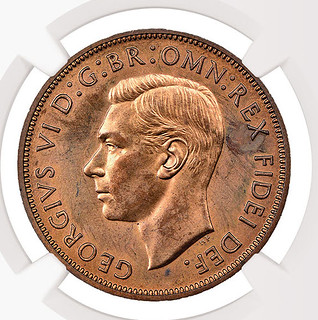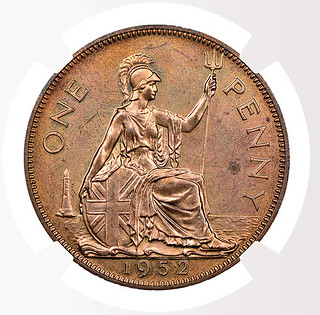
PREV ARTICLE
NEXT ARTICLE
FULL ISSUE
PREV FULL ISSUE
THE UNIQUE 1952 GEORGE VI PROOF PENNYThis week Numismatic Guaranty Corporation announced it had certified a unique 1952 Great Britain Penny. Sovereign Rarities is offering the piece at fixed price. Steve Hill kindly provided this detailed description. Thanks! -Editor GEORGE VI 1952 PROOF PENNY, THE ONLY EXAMPLE THAT EXISTS, UNIQUE PF64RB   George VI (1936-52), Proof Penny, 1952, second issue (1949-52), bare head in profile left, raised HP below, initials of designer Thomas Humphrey Paget, legend commences lower left with toothed border surrounding, GEORGIVS VI D: G: BR: OMN: REX FIDEI DEF:, rev. struck en medaille, Britannia seated right with heraldic shield and trident, crested waves below, sea beyond each side with lighthouse at left, date in exergue, denomination as legend surrounding with toothed border, ONE PENNY, weight 9.52g (Peck - reverse B; Fr. - dies 3+C; S.4117). Attractively toned with full underlying brilliance and lustre, one darker patch of tone at X of obverse legend, small spot below truncation, one tone spot on reverse field under last N of legend, otherwise as struck and the only example known to exist, has been slabbed and graded by NGC as PF64RB, Unique! The abbreviated Latin legend translates as "George the Sixth, by the grace of God, King of all the Britains, Defender of the Faith" the Emperor of India title having been dropped since 1949. Provenance: Ex A. H. Baldwin, 125th Anniversary sale, a Celebration 1872-1997, 13th October 1997, lot 67.
This intriguing proof coin is the rarest proof penny of the entire series of copper and bronze pennies, with a rarity on par with the unique currency George III 1808 Penny and the unique currency Elizabeth II 1954 Penny both of which are not proofs like the 1952. The existence of this unique 1952 Proof Penny was not known publicly until its initial appearance at numismatic auction in October of 1997 some 45 years after it was struck. The specialised reference books by Peck and Freeman did not list a 1952 Penny as proof or currency and both authors went as far as to say that "no pennies dated 1952 were struck" which is repeated on page 67 of the 2006 reprint of Freeman and page 514 of Peck. Coin Yearbook still does not list it, but the Spink Standard Catalogue does as "unique" but without a suggested retail price. The British Numismatic world was astonished to see this coin appear in the A. H. Baldwin 125th anniversary auction on the evening of the 13th October 1997, an auction that drew on coins selected from the famed "basement" stock cache of rare and unusual coins belonging to then family business. As the Foreword of this auction catalogue states "Over the years rare, interesting and splendidly struck specimens have been set aside for our own enjoyment" having already mentioned that the five generation family business had had the pleasure of many years dealing, handling, and researching countless unusual and beautiful pieces. This proof coin appeared for sale as lot 67 at the auction with the following one-line description "George VI, Proof Penny 1952. Spot on reverse, otherwise mint state and believed unique" with a mere footnote to say "There was no currency issue of this date." The coin fetched £23,468 including premium on that evening just over 22 years ago and sold to Spink, who sold it the following day to the premier UK collector of the rare pennies at that time. This unique 1952 Proof Penny along with two of the other rare pennies (Edward VIII 1937 Proof and 1954 currency) then passed privately some five years later to the next major Penny collector to emerge in the UK; who retained it till 2006 when it was sold as part of the "Parry" Collection. The same trio of rare pennies and the 1933 currency Penny in Parry, then moved on to the next major collector who had emerged based overseas. Subsequent selections of the overseas collection then appeared for sale in the Rasmussen list of Spring 2018, including the unique 1952 Proof Penny and the unique 1808 currency copper Penny. The 1808 currency copper Penny has since been auctioned on 24th September 2019 by Spink as part of the "Waterbird" Collection where it fetched £90,000 including premium. This sale also contained the extremely rare Edward VIII Proof Penny dated 1937, one of two in private ownership, though it seems a total of six pieces exist, which achieved £133,200 including the buyer's premium. The other great classic rarity of the Penny series is the more common 1933 Penny of which there would seem to be seven examples in existence, three of which are held privately. The most recent example of which was sold publicly at the Heritage Auction held in the USA on the 11th August 2016 for a total of $198,000 including premium. There are also four known pattern pennies dated 1933 of a different obverse and reverse design by Frenchman Andre Lavrillier, which are also highly coveted and valuable. The existence of the 1933 Penny was not realised properly by collectors till many years afterwards (in a similar vein to the unique 1952 Proof Penny) as the mint did not officially mint any for currency purposes. The small number struck were for proof of record and mainly for ceremonial use as a component part of proof sets for building foundation stone placements. The first 1933 Penny to ever appear at auction sale was within a date run of all bronze 20th Century coins offered as one lot in a 1951 Glendining sale, and went nearly unnoticed as an eighteen year-old modern coin in a 615 coin quantity lot. The significance of the coin only becoming more prominent and apparent in the late 1950s and early 1960s as the craze for checking change became more prevalent with the plans to withdraw pre-decimal coinage. The unique 1954 currency penny was discovered in change in 1956 and sold to C. Wilson Peck for instance (Peck 2508). The value of the 1933 Penny at auction therefore only escalated upon the next auction appearance in 1969 some 35 years after the striking of the coins and from then onwards. It is perhaps understandable that the George VI 1952 Proof Penny remains a Unique piece, as the King died very early in 1952 passing away on 6th February. Only the smaller denominations of currency coins that were in great demand were struck for circulation in 1952, with the larger denominations omitted in anticipation of a new reign and a new coinage for Queen Elizabeth II. The only mass-produced currency coins dated 1952 are the Sixpence which is rare, brass Threepence, Halfpenny and Farthing. As for the larger denominations the 1952 Halfcrown is known from one currency striking and one proof striking only, the latter was also in the 1997 Baldwin 125th Anniversary sale. There is no 1952 Florin known at all or a Scottish reverse Shilling. There is a unique proof English reverse Shilling, and then there is the unique 1952 Proof Penny offered herewith. We also find it interesting to note that there is one extremely rare or unique rare proof pre-decimal Penny for each monarch of the house of Windsor, George V has the 1933 Penny, Edward VIII the 1937 Proof Penny, George VI this unique 1952 Proof Penny and Elizabeth II the unique 1954 currency Penny. The 1952 Proof Penny remains an enigma as the only unique Proof striking of a pre-decimal Penny of the 20th Century. £175,000 To visit the Sovereign Rarities web site, see:
THE BOOK BAZARREWayne Homren, Editor The Numismatic Bibliomania Society is a non-profit organization promoting numismatic literature. See our web site at coinbooks.org. To submit items for publication in The E-Sylum, write to the Editor at this address: whomren@gmail.com To subscribe go to: https://my.binhost.com/lists/listinfo/esylum All Rights Reserved. NBS Home Page Contact the NBS webmaster 
|